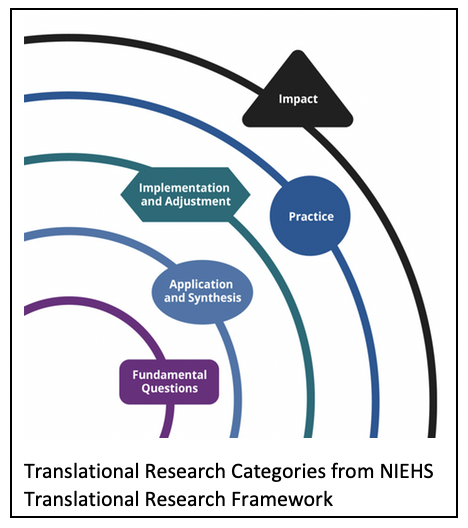
Welcome y’all. I’m Kristi Pettibone and I have been an evaluator with the National Institute of Environmental Health Sciences (NIEHS) in Durham, NC for almost 10 years. We are one of the 27 institutes that make up the National Institutes of Health and are the only one that is not in the Bethesda/DC area. One of my responsibilities is to evaluate the impact of our research portfolio and communicate the value of our investments in basic, biomedical research.

In 2018 I worked with a group of people from NIEHS to develop a framework that illustrates the translational research process for environmental health research. We used the National Center for Advancing Clinical and Translational Science’s (NCATS) Translational Science Spectrum as the foundation of our framework and built on that to expand the framework to reflect the work of the environmental health science field, which tends to have more of a public health rather than a clinical impact.
One of the unique characteristics of our framework, which is explained in this article, is that we define translational research as movement through the translational research process. Using our model, translational research can be defined as movement from one translational research category to another (ring to ring). Each ring also includes nodes that describe activities that might be conducted within that translational research category. Because the activities that occur in each of these nodes require different types of training, tools, resources and knowledge, we count movement from node to node, around the ring, as translational research as well.
We use the framework to map out and evaluate the translational research efforts of our grantees. With this information, we can identify the strategies that help speed up the translational research process.
Hot Tips:
Use EndNote or another publication management system to keep track of the citations that support your story.
You are the author of your story, so you get to decide where the story starts and where it ends.
Rad Resources:
We pulled together several templates that you can use to map out your own translational story. These resources include graphics to illustrate your translational research story as well as a template you can use to identify and describe the key milestones of your translational story.
We also have a checklist that can help determine where a certain translational research activity could be mapped using the framework. This tool is still in development so if you have any feedback on how to improve it, we would love to hear from you!
Because our webpages are 508 compliant, we cannot put editable versions of these resources on the webpage, but we are happy to share these upon request. Just send me an email at pettibonekg@niehs.nih.gov.
The American Evaluation Association is celebrating Translational Research Evaluation (TRE) TIG week. All posts this week are contributed by members of the TRE Topical Interest Group. Do you have questions, concerns, kudos, or content to extend this aea365 contribution? Please add them in the comments section for this post on the aea365 webpage so that we may enrich our community of practice. Would you like to submit an aea365 Tip? Please send a note of interest to aea365@eval.org. aea365 is sponsored by the American Evaluation Association and provides a Tip-a-Day by and for evaluators.

Impressive content! This is a valuable resource. Thanks for sharing!